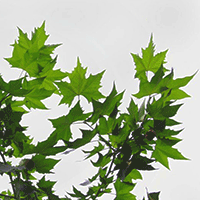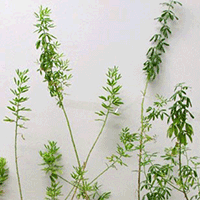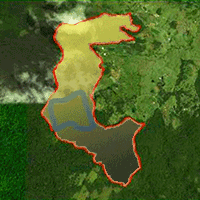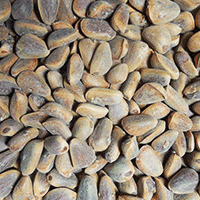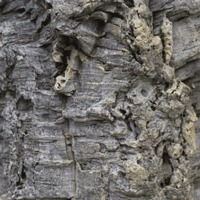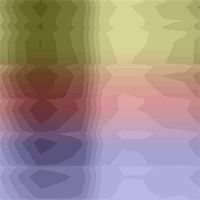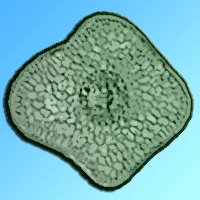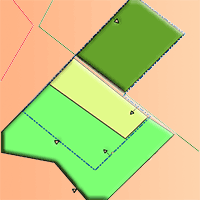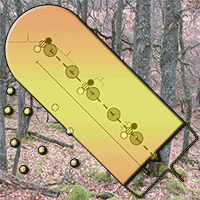Attributes and frequency of forest gaps are usually described in reference to a one-dimensional gradient of light, which may relate to their disturbance dynamics. Similarly, species are customarily classified by their light response. We propose that a bi-dimensional light framework facilitates the understanding and comparison of forest systems and the understanding of plant responses to the complex light environment. This light plane is based on two spatially related components: 1) light received directly on a particular point (Focal); and 2) a statistical summary of the immediate environment representing the light conditions surrounding that point (Context). The contrast between these two values is null when Focal = Context and positive when Focal > Context or otherwise negative. Light was assessed using hemispherical photographs using a spatial arrangement of pictures spaced ~3 metres (m) in-between. Eight forest plots were surveyed, each with a central gap of different size. Sapling performance of Alnus acuminata, Cornus excelsa, Liquidambar styraciflua, Persea americana and Quercus laurina was also assessed within these plots. Measurements of stem height, basal diameter, and slenderness allometry were taken over a period of more than two years. We found in the light plane that plots were distributed in a pattern congruent with their estimated degree of disturbance (gap size), which spanned wide areas in the plane. Liquidambar styraciflua. and Quercus laurina were found to be sensitive to Focal light, irrespective of Context light. All species responded to Focal light under negative Contrast. Cornus and Persea grew taller and more slender as Focal light increased, particularly under null contrast. There is evidence suggesting that plant growth is dependent on the contrast measured. Thus, it would be relevant to devise a functional classification of tree species that considers their response to both direct light and luminosity of the immediate environment as measured by a contrast value.
Keywords
, , , , ,
Citation
Méndez-Dewar G, González-Espinosa M, Equihua M (2014). Spatial heterogeneity of light and tree sapling responses in the understory of disturbed montane forests. iForest 8: 448-455. - doi: 10.3832/ifor1195-007
Academic Editor
Francesco Ripullone
Paper history
Received: Dec 04, 2013
Accepted: Jul 24, 2014
First online: Oct 08, 2014
Publication Date: Aug 02, 2015
Publication Time: 2.53 months
© SISEF - The Italian Society of Silviculture and Forest Ecology 2014
Open Access
This article is distributed under the terms of the Creative Commons Attribution-Non Commercial 4.0 International (https://creativecommons.org/licenses/by-nc/4.0/), which permits unrestricted use, distribution, and reproduction in any medium, provided you give appropriate credit to the original author(s) and the source, provide a link to the Creative Commons license, and indicate if changes were made.

Breakdown by View Type
(Waiting for server response...)
Article Usage
Total Article Views: 53465
(from publication date up to now)
Breakdown by View Type
HTML Page Views: 45587
Abstract Page Views: 2602
PDF Downloads: 3834
Citation/Reference Downloads: 27
XML Downloads: 1415
Web Metrics
Days since publication: 4102
Overall contacts: 53465
Avg. contacts per week: 91.24
Article Citations
Article citations are based on data periodically collected from the Clarivate Web of Science web site
(last update: Mar 2025)
Total number of cites (since 2015): 3
Average cites per year: 0.27
Publication Metrics
by Dimensions ©
Articles citing this article
List of the papers citing this article based on CrossRef Cited-by.
(1)
Baroloto C, Couteron P (2010)Fine-scale microhabitat heterogeneity in a French Guiana forest. Biotropica 42: 420-428.
CrossRef |
Gscholar
(2)
Bazzaz FA (1996)Plants in changing environments: linking physiological, population and community ecology. Cambridge University Press, Cambridge, UK, pp. 322.
Online |
Gscholar
(3)
Breedlove DE (1981)Flora of Chiapas. Part 1: introduction to the flora of Chiapas. Academy of Sciences, S Francisco, CA, USA, pp. 35.
Gscholar
(4)
Brenes-Arguedas T, Roddy AB, Coley PD, Kursar TA (2011)Do differences in understory light contribute to species distributions along a tropical rainfall gradient? Oecologia 166: 443-456.
CrossRef |
Gscholar
(5)
Bugmann H (2001)A review of forest gap models. Climatic Change 51: 259-305.
CrossRef |
Gscholar
(6)
Canham CD (1989)Different responses to gaps among shade-tolerant tree species. Ecology 70: 548-550.
CrossRef |
Gscholar
(7)
Canham CD, Denslow JS, Platt WJ, Runkle JR, Spies TA, White PS (1990)Light regimes beneath closed canopies and tree-fall gaps in temperate and tropical forests. Canadian Journal of Forest Research 20: 620-631.
CrossRef |
Gscholar
(8)
Chapin FS, Bloom AJ, Field CB, Waring RH (1987)Plant responses to multiple environmental factors. BioScience 37: 49-57.
CrossRef |
Gscholar
(9)
Chazdon RL (1988)Sunflecks and their importance to forest understory plants. Advances in Ecological Research 18: 2-54.
Online |
Gscholar
(10)
Chazdon RL, Pearcy RW (1991)The importance of sunflecks for forest understory plants. BioScience 41: 760-766.
CrossRef |
Gscholar
(11)
Coleman JS, McConnaughay KDM, Ackerley DD (1994)Interpreting phenotypic variation in plants. Trends in Ecology and Evolution 9: 187-191.
CrossRef |
Gscholar
(12)
Comeau PG (2002)Relationships between stand parameters and understorey light in boreal aspen stands. Journal of Ecosystems and Management 1: 1-8.
Online |
Gscholar
(13)
Coomes DA, Grubb PJ (2000)Impacts of root competition in forests and woodlands: a theoretical framework and review of experiments. Ecological Monographs 70: 171-207.
CrossRef |
Gscholar
(14)
Coutand C, Chevolot M, Lacointe A, Rowe N, Scotti I (2010)Mechanosensing of stem bending and its interspecific variability in five neotropical rainforest species. Annals of Botany 105: 341-347.
CrossRef |
Gscholar
(15)
Denslow JS (1987)Tropical rain forest gaps and tree species diversity. Annual Review of Ecology and Systematics 18: 431-451.
CrossRef |
Gscholar
(16)
Denslow JS, Ellison AM, Sanford RE (1998)Treefall gap size effects on above- and below- ground processes in a tropical wet forest. Journal of Ecology 86: 597-609.
CrossRef |
Gscholar
(17)
Deutschman DH, Levin SA, Pacala SW (1999)Error propagation in a forest succession model: the role of fine-scale heterogeneity in light. Ecology 80:1927-1943.
CrossRef |
Gscholar
(18)
Ediriweera S, Singhakumara BMP, Ashton MS (2008)Variation in canopy structure, light and soil nutrition across elevation of a Sri Lankan tropical rain forest. Forest Ecology and Management 256: 1339-1349.
CrossRef |
Gscholar
(19)
FORTAM (1984)Huixtán: diagnóstico municipal [Huixtán: Municipal diagnosis]. Fortalecimiento Municipal, Plan Chiapas, Tuxtla Gutiérrez, Mexico.
Gscholar
(20)
Gómez JM (2003)Spatial patterns in long-distance dispersal of
Quercus ilex acorns by jays in a heterogeneous landscape. Ecography 26: 573-584.
CrossRef |
Gscholar
(21)
González-Espinosa M, Quintana-Ascencio PF, Ramírez-Marcial N, Gaytán-Guzmán P (1991)Secondary succession in disturbed
Pinus-Quercus forests of the highlands of Chiapas, México. Journal of Vegetation Science 2: 351-360.
CrossRef |
Gscholar
(22)
González-Espinosa M, Meave JA, Lorea-Hernández FG, Ibarra-Manríquez G, Newton AC (2011)The Red List of Mexican cloud forest trees. Fauna and Flora International, Cambridge, UK, pp. 148.
Online |
Gscholar
(23)
Hanba YT, Kogami H, Terashima I (2002)The effect of growth irradiance on leaf anatomy and photosynthesis in
Acer species differing in light demand. Plant, Cell and Environment 25: 1021-1030.
CrossRef |
Gscholar
(24)
Huante P, Rincón E, Chapin FS III (1998)Effect of changing light availability on nutrient foraging in tropical deciduous tree-seedlings. Oikos 82: 449-458.
CrossRef |
Gscholar
(25)
Hutchings MJ, Wijesinghe DK (1997)Patchy habitats, division of labour and growth dividends in clonal plants. Trends in Ecology and Evolution 12: 390-394.
CrossRef |
Gscholar
(26)
IBM Corp (2010)IBM SPSS Statistics for Windows (version 19.0). Armonk, NY, USA.
Gscholar
(27)
Kitajima K (1994)Relative importance of photosynthetic traits and allocation patterns as correlates of seedling shade tolerance of 13 tropical trees. Oecologia 98: 419-428.
CrossRef |
Gscholar
(28)
Kitao M, Lei TT, Koike T, Tobita H, Maruyama Y (2006)Tradeoff between shade adaptation and mitigation of photoinhibition in leaves of
Quercus mongolica and
Acer mono acclimated to deep shade. Tree Physiology 26: 441-448.
CrossRef |
Gscholar
(29)
Kolasa J, Rollo C (1991)Introduction: the heterogeneity of heterogeneity: a glossary. In: “Ecological heterogeneity” (Kolasa J, Pickett STA eds). Springer, New York, USA, pp. 1-23.
CrossRef |
Gscholar
(30)
Kotliar NB, Wiens JA (1990)Multiple scales of patchiness and patch structure: a hierarchical framework for the study of heterogeneity. Oikos 59: 253-260.
CrossRef |
Gscholar
(31)
Küppers M (1985)Carbon relations and competition between woody species in a Central European hedgerow. Oecologia 66: 343-352.
CrossRef |
Gscholar
(32)
Leakey AD, Scholes JD, Press MC (2005)Physiological and ecological significance of sunflecks for dipterocarp seedlings. Journal of Experimental Botany 56: 469-482.
CrossRef |
Gscholar
(33)
Lieberman M, Lieberman D, Peralta R (1989)Forests are not just Swiss cheese: canopy stereogeometry of non-gaps in tropical forests. Ecology 70: 550-552.
CrossRef |
Gscholar
(34)
Lieffers VJ, Messier C, Stadt KJ, Gendron F, Comeau PG (1999)Predicting and managing light in the understory of boreal forests. Canadian Journal of Forest Research 29: 796-811.
CrossRef |
Gscholar
(35)
Lusk CH (2004)Leaf area and growth of juvenile temperate evergreens in low light: species of contrasting shade tolerance change rank during ontogeny. Functional Ecology 18: 820-828.
CrossRef |
Gscholar
(36)
Marthews T, Burslem D, Phillips R, Mullins C (2008)Modelling direct radiation and canopy gap regimes in tropical forests. Biotropica 40: 676-685.
CrossRef |
Gscholar
(37)
McDonald RI, Urban DL (2004)Forest edges and tree growth rates in the North Carolina Piedmont. Ecology 85: 2258-2266.
CrossRef |
Gscholar
(38)
Montgomery RA, Chazdon RL (2002)Light gradient partitioning by tropical tree seedlings in the absence of canopy gaps. Oecologia 131: 165-174.
CrossRef |
Gscholar
(39)
Naumburg E, Ellsworth DS, Katul GG (2001)Modeling dynamic understory photosynthesis of contrasting species in ambient and elevated carbon dioxide. Oecologia 126: 487-499.
CrossRef |
Gscholar
(40)
Nicotra A, Chazdon RL, Iriarte SV (1999)Spatial heterogeneity of light and woody seedling regeneration in tropical wet forests. Ecology 80: 1908-1926.
CrossRef |
Gscholar
(41)
Niinemets U (1998)Growth of young trees of
Acer platanoides and
Quercus robur along a gap-understory continuum: interrelationships between allometry, biomass partitioning, nitrogen and shade-tolerance. International Journal of Plant Sciences 159: 318-330.
CrossRef |
Gscholar
(42)
Norby RJ, Ogle K, Curtis PS, Badeck FW, Huth A, Hurtt GC, Kohyama T, Peñuelas J (2001)Aboveground growth and competition in forest gap models: an analysis for studies of climatic change. Climatic Change 51: 415-447.
CrossRef |
Gscholar
(43)
Osunkoya OO, Ash JE, Hopkins MS, Graham AW (1992)Factors affecting survival of tree seedlings in North Queensland rainforests. Oecologia 91: 569-578.
CrossRef |
Gscholar
(44)
Osunkoya OO, Ash JE, Hopkins MS, Graham AW (1994)Influence of seed size and seedling ecological attributes on shade-tolerance of rain-forest tree species in northern Queensland. Journal of Ecology 82: 149-163.
CrossRef |
Gscholar
(45)
Parrish JAA, Bazzaz FA (1985)Ontogenetic niche shifts in old-field annuals. Ecology 66: 1296-1302.
CrossRef |
Gscholar
(46)
Pearcy RW (1983)The light environment and growth of C3 and C4 species in the understorey of a Hawaiian forest. Oecologia 58: 26-32.
CrossRef |
Gscholar
(47)
Pearcy RW (1999)Responses of plants to heterogeneous light environments. In: “Handbook of functional plant ecology” (Pugnaire F, Valladares F eds). Marcel Dekker, New York, USA, pp. 269-314.
Gscholar
(48)
Pearcy RW, Chazdon RL, Gross LJ, Mott KA (1994)Photosynthetic utilization of sunflecks, a temporally patchy resource on a time scale of seconds to minutes. In: “Exploitation of environmental heterogeneity by plants: Ecophysiological processes above and below ground” (Caldwell MM, Pearcy RW eds). Academic Press, San Diego, CA, USA, pp. 175-208.
CrossRef |
Gscholar
(49)
Poorter L, Bongers F, Sterck FJ, Woll H (2005)Beyond the regeneration phase: differentiation of height-light trajectories among tropical tree species. Journal of Ecology 93:256-267.
CrossRef |
Gscholar
(50)
Powles SB (1984)Photoinhibition of photosynthesis induced by visible light. Annual Review in Plant Physiology 35:15-44.
CrossRef |
Gscholar
(51)
R Development Core Team (2008)R: a language and environment for statistical computing (version 3.0.2). R Foundation for Statistical Computing, Vienna, Austria.
Online |
Gscholar
(52)
Rozendaal DMA, Hurtado VH, Poorter L (2006)Plasticity in leaf traits of 38 tropical tree species in response to light; relationships with light demand and adult stature. Functional Ecology 20: 207-216.
CrossRef |
Gscholar
(53)
Runkle JR (1981)Gap regeneration in some old-growth forests of the eastern United States. Ecology 62: 1041-1051.
CrossRef |
Gscholar
(54)
RStudio (2012)RStudio: integrated development environment for R (version 0.97.551). Boston, MA, USA.
Online |
Gscholar
(55)
Sims DA, Pearcy RW (1993)Sunfleck frequency and duration affects growth rate in understory plant,
Alocasia macrorrhiza. Functional Ecology 7: 683-689.
CrossRef |
Gscholar
(56)
Smith W, Knapp A, Reiners W (1989)Penumbral effects on sunlight penetration in plant communities. Ecology 70: 1603-1609.
CrossRef |
Gscholar
(57)
Smith WK, Berry ZC (2013)Sunflecks? Tree physiology 33: 233-237.
CrossRef |
Gscholar
(58)
Stuefer JF (1996)Potential and limitations of current concepts regarding the response of clonal plants to environmental heterogeneity. Vegetatio 127: 55-70.
CrossRef |
Gscholar
(59)
Stuefer JF, During H, de Kroon H (1994)High benefits of clonal integration in stoloniferous species in response to heterogeneous light environments. Journal of Ecology 82: 511-518.
CrossRef |
Gscholar
(60)
Ter Steege H (1994)Hemiphot: a programme to analyze vegetation indices, light and light quality from hemispherical photographs. Tropenbos, Wageningen, The Netherlands, pp. 44.
Gscholar
(61)
Valladares F (2003)Light heterogeneity and plants: from ecophysiology to species coexistence and biodiversity. Progress in Botany 64: 439-471.
CrossRef |
Gscholar
(62)
Valladares F, Aranda I, Sánchez-Gómez D (2004)La luz como factor ecológico y evolutivo para las plantas y su interacción con el agua [Light as an ecological and evolutionary factor for plants and their interaction with water]. In: “Ecología del bosque mediterráneo en un mundo cambiante” (Valladares F ed). Organismo Autónomo de Parques Nacionales. Ministerio de Medio Ambiente, Madrid, Spain, pp. 335-369.
Gscholar
(63)
Veblen TT (1989)Tree regeneration responses to gaps along a trans Andean gradient. Ecology 70: 541-543.
CrossRef |
Gscholar
(64)
Walters M, Reich P (1999)Low-light carbon balance and shade tolerance in the seedlings of woody plants: do winter deciduous and broad-leaved evergreen species differ? New Phytologist 143: 143-154.
CrossRef |
Gscholar
(65)
Wayne PM, Bazzaz FA (1993)Birch seedling responses to daily time courses of light in experimental forest gaps and shadehouses. Ecology 74: 1500-1515.
CrossRef |
Gscholar
(66)
Weis E, Berry JA (1988)Plants and high temperature stress. Symposia of the Society for Experimental Biology 42: 329-346.
Gscholar
(67)
Wolstenholme B, Whiley A (1999)Ecophysiology of the avocado (
Persea americana Mill.) tree as a basis for pre-harvest management. Revista Chapingo Serie Horticultura 5: 77-88.
Online |
Gscholar


